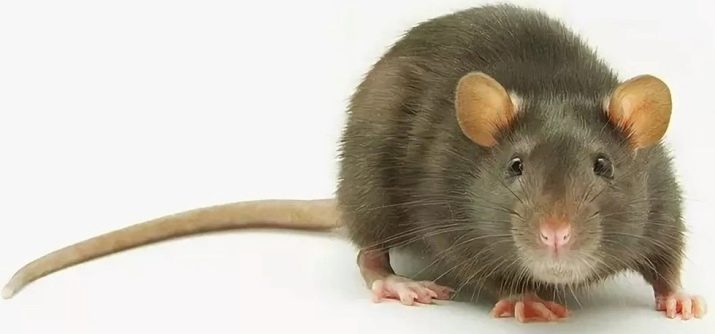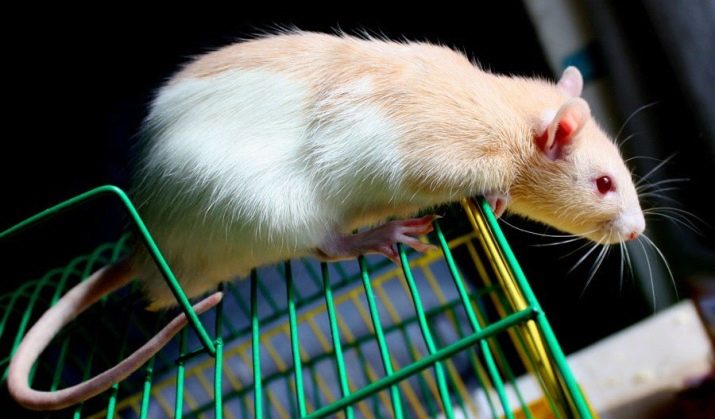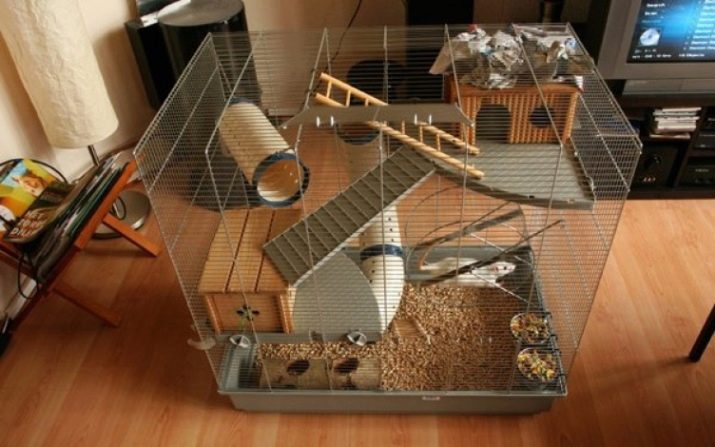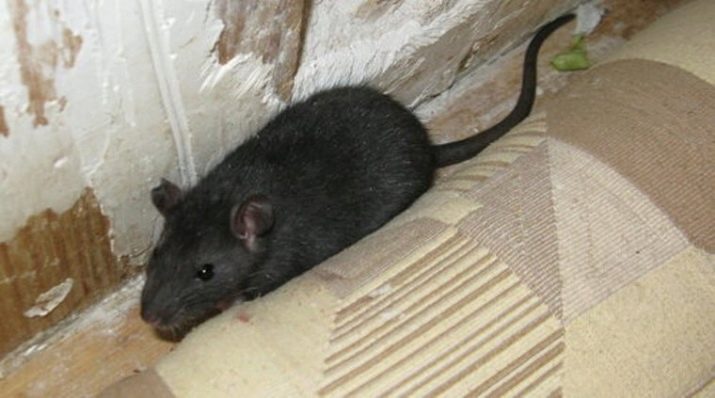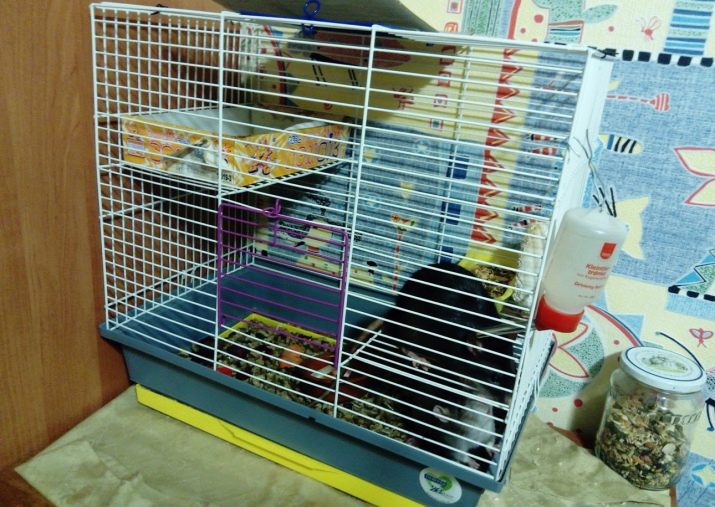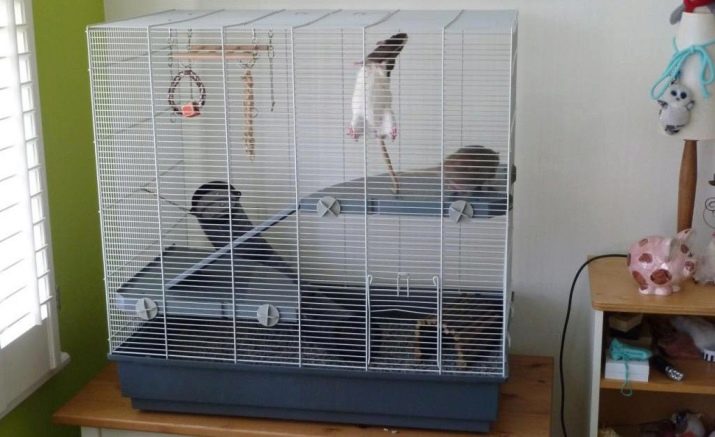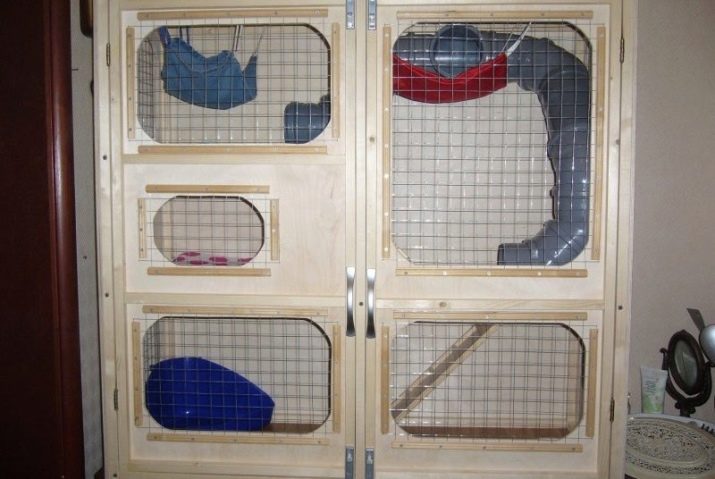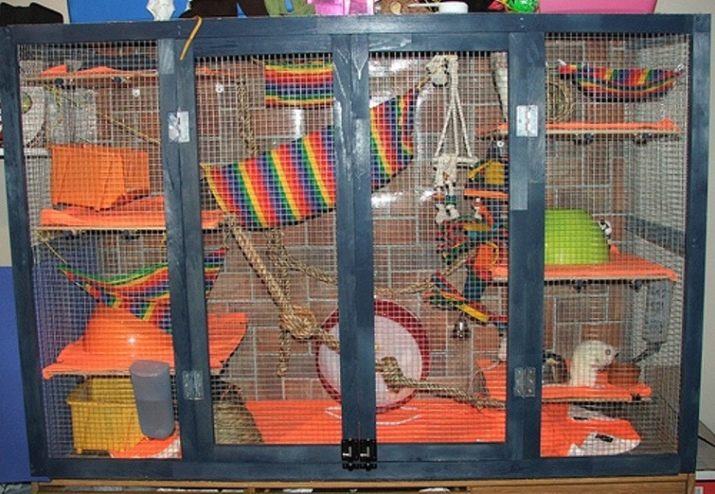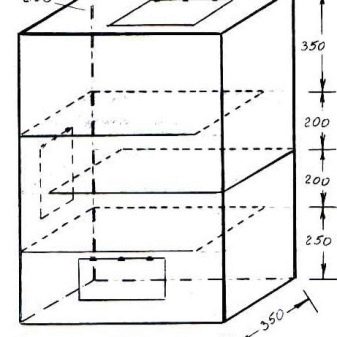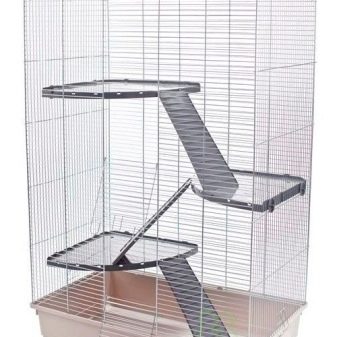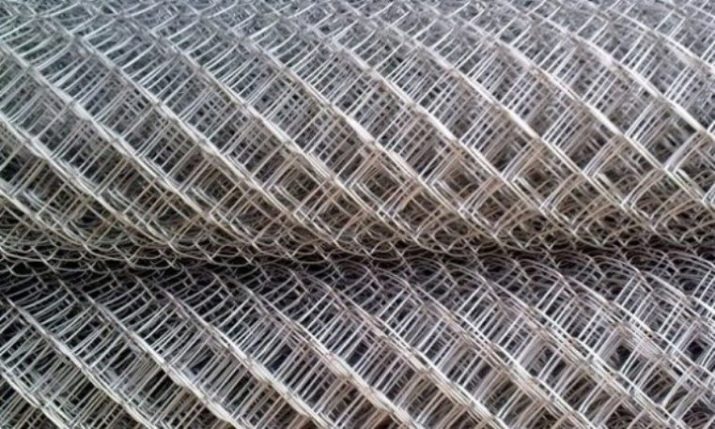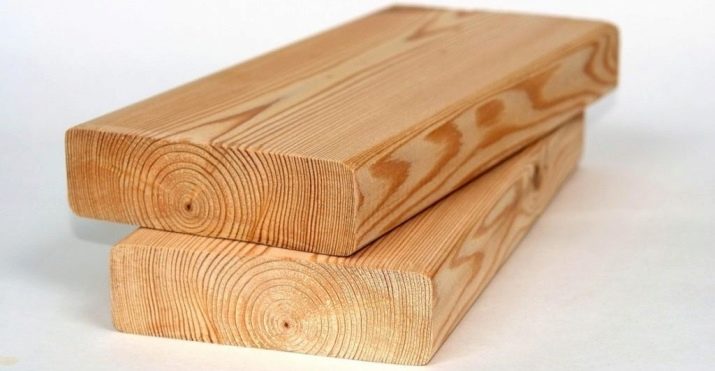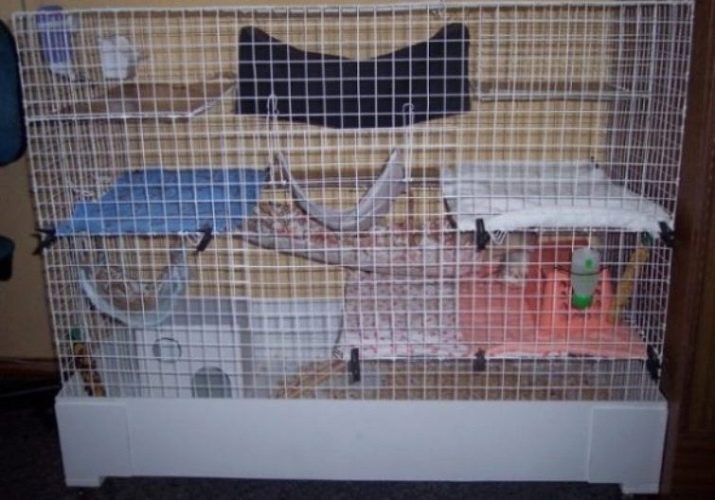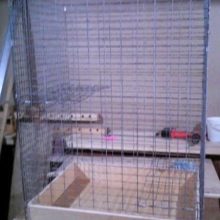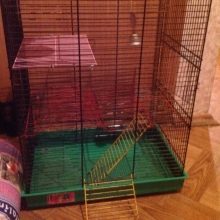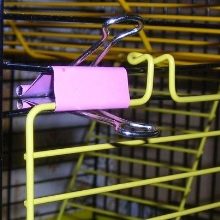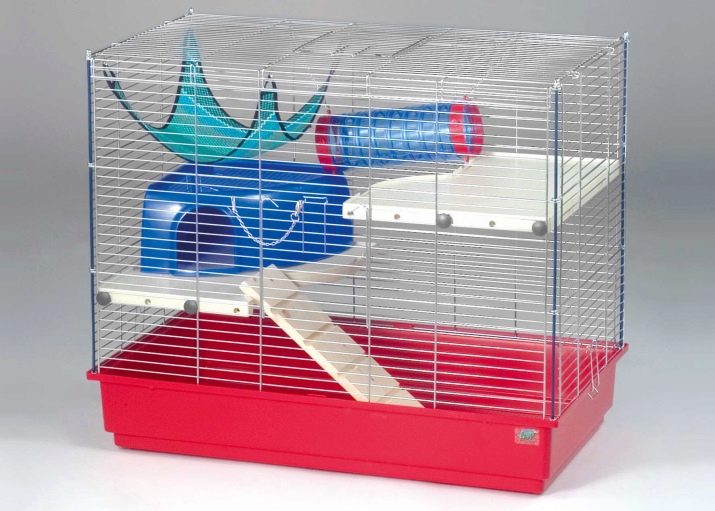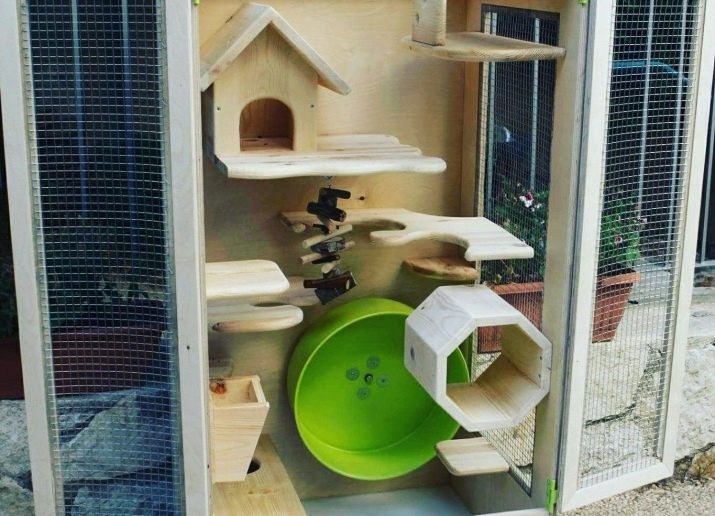Cages for rats do it yourself: options and step by step instructions
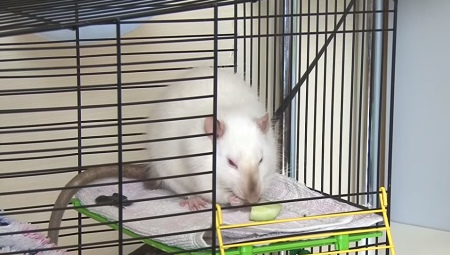
Rats are small animals from the mouse family belonging to the genus of rodents. Characteristic features - a variety of fur colors: from gray-brown to white, the presence of a bare leathery tail, protruding front cutters. The body length of a medium-sized rat can vary between 10-30 cm, with the tail length being equal to the body length. Average weight range from 80-150 grams.
The characteristic physiological features of the body structure of a rat provide it with a number of indisputable advantages: ability to free manipulation of the front limbs, flexible spine, oblong form of the body.
Due to these features, rats can lead a full-fledged lifestyle in conditions that are critical for other mammals.
Modern technologies of animal breeding allowed breeding rats adapted for living at home. In this regard, the development of the production of mini-houses for domesticated rodents. The zoo market represents a wide range of ready-made rat cages, however, self-design will save money.
Design features
A house for decorative rats, assembled by hand, must meet the main criteria for the content. Among them are:
- resistance to gnawing;
- the lack of design features involving the penetration of the rodent out;
- minimal possibility of animals getting injured.
It must be borne in mind that the cage is a limiting factor for the rat. Even an artificially bred animal will make constant attempts to escape.
This is due to her innate instinct, especially during mating. Uncontrolled penetration of rats beyond the cage is unacceptable. A rodent can in a short time cause significant damage to the property of the owner. If the escape of a rat falls on the period of "walking", it will taste everything that gets in its way in order to ensure the availability of the material necessary for the formation of the nest.
Dimensions
The dimensional parameters of the cell are directly dependent on the number of individuals that will live in it, as well as on their gender and age. Each individual must have at least 50 cubic centimeters of free space.
When calculating the size, it is the available volume that is taken into account, not the area, since the rat can use the cage space in all directions. Attention is paid to the presence of additional devices that will be located inside the cell. The space that they occupy should not be part of the space reserved for the free movement of the animal.
The optimal size of a cage designed for one individual is the size of which implies a minimum length of each side of 50 cm.
Forms
Characteristics of the shape of the cage for the rat are determined by the specific needs of each individual, as well as the parameters of individual design. The main criterion determining the shape of the cage is the construction of its upper part - the roof. It can be triangular, oval, flat or combined.
The most common form of the cell is cubic, suggesting the presence of a flat roof and even walls. This form allows you to use the available internal space as efficiently as possible.
Materials
The design of the cage and the materials from which it is made must be resistant to attempts by the rat to gnaw through them. This rule applies to the elements of the frame, the walls of the cell and to the internal accessories. All soft materials such as plastic and wood used in the construction of the cage must be adequately protected.
Advantages and disadvantages
Self-made rat cages, like other handicrafts, have a number of advantages and disadvantages. Among the advantages are the following.
- Cost In comparison with the store options, homemade cell will be much cheaper. This is due to the fact that during its assembly you can use the available materials that are available.
- The cage collected at home can be adapted to the specific characteristics of the available interior. You can vary the size parameters: width, height and shape.
Among the minuses can be noted that self-assembly implies an underestimated level of aesthetic appearance. This factor is due to the fact that in the manufacture of construction parts, tools with a low percentage of accuracy — non-professional — are used. Shop counterparts are made using automated machines that provide the best appearance of the product.
How to make and equip?
In order to make a cage for a rat at home, it is necessary to carry out preliminary calculations, including an assessment of the characteristics of the individuals who will live in it, to make detailed drawings. The drawing scheme should contain the size designations of one or another part of the structure, verified in advance.
In the process it is important to adhere precisely to the scheme, this will allow you to complete the assembly with maximum accuracy and provide the best final appearance of the product.
It is worth paying enough attention to the choice of materials from which the cell will be constructed. Optimal names for materials are stainless steel mesh or grating, natural wood, plastic. Metal elements should be selected based on the characteristics of each individual animal.
The size of the grid cells or the distance between the grids should not allow the rodent to leave the dwelling.
Wooden elements should be made of planed (ground) material. The presence of cracks, roughness, splinters and other defects is excluded. The dimensions of wooden elements should not exceed the permissible maximum, as this parameter affects the weight of the whole structure.
For the manufacture of the bottom tray and the floor of the cage, you can use plywood or fiberboard. The first option is effective in terms of resistance to stress, and the second provides low weights of the finished product.
Regardless of what material is used for the arrangement of the lower part of the cage, it should be treated with any kind of paint coating. This is necessary to prevent the animal from absorbing secretions into the wooden surface and then fixing the smell.
The build goes like this
It is necessary to cut billets from wooden slats. The dimensions of the blanks should correspond to those indicated on the drawing. The resulting parts are connected in such a way that a frame is formed, which is a cube or parallelepiped. All open space must be picked up with a grid or mesh. This manipulation involves attaching parts from the inside and protects wooden structures from gnawing. In the front of the cage is mounted door.
It must be equipped with an appropriate locking mechanism, since the physiological features and the presence of a natural instinct allow rats to open the simplest locks themselves.
The dwelling for an ornamental rat must be equipped with various devices designed to give it the opportunity to feel in its natural habitat. As such additions can be:
- swing;
- wheels;
- mazes;
- tunnels;
- hammocks;
- ropes.
Interesting examples
This photo shows the factory version of the rat cage. On a similar principle, you can equip a homemade equivalent of a dwelling for a rodent. This modification assumes the presence of two floors. One of them has a mini-house imitating a hole. There is a tunnel that provides access to a fabric hammock located above the hole. Access to the tiers is provided by special ladders.
The construction of the cage depicted in the photo, involves the use of the maximum amount of wooden materials, and the number of metal minimizes. In this model, there are 4 levels on which a rodent can live. In addition, each of the levels has one or another device, creating the effect of living an animal in a free environment. These devices include a house with a circular inlet, a suspension ladder, a wooden tunnel and others.
An important element that complements the cage design is the running wheel. It allows the animal to receive sufficient physical activity, positively influencing the state of his health.
How to make a cage for rats with your own hands without too much difficulty, you can see in the next video.
